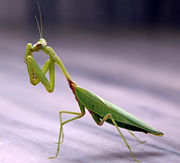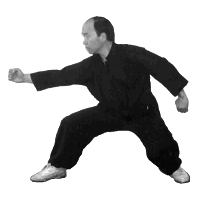STYLES:
PRAYING MANTIS
History of Style

Praying Mantis Boxing was created in the late 1600’s during the late Ming Dynasty in Shantung Province by a man named Wong Long. The story of the creation of this style is legendary – with a few variations in the telling. What is known with certainty is that styles calling themselves Tanglang predate Wong by over 1000 years but all hat exist today trace themselves to him. His father was arrested as an anti-Manchurian rebel and this is likely why Wong, Long famously trained at Shaolin – the monks were known to harbor rebels at the time. It is said he combined the 18 best techniques he could find – including his own signature Hook Hand or Mantis Hand “Gou Shou” techniques. His art has since branched into numerous sub-styles but all seek to retain and express the original essence of Tanglang as taught by Wong, Long.
Here are some of the stories of the styles origin:
Wong, Long was an expert boxer of several different styles who came to the Shaolin Temple to challenge the legendary monks to a fight. The Shaolin monks were known throughout China for their prowess in Wushu and were believed by many to be unbeatable. Wong wanted to see for himself if the legends were true. He eventually reached the Shaolin Temple and challenged the head monk to a duel, but the head monk of Shaolin referred him to a novice student instead. To Wong's surprise, the novice monk easily defeated him. Ashamed of his defeat, Wong retreated to the mountains to improve his boxing techniques.
After some time training, Wong returned to Shaolin to challenge the monk again. Wong defeated the monk who had previously defeated him and worked his way up to the head monk. Once again confident about his boxing, Wong believed he would defeat the head monk easily. But again he was defeated; every technique he threw at the head monk seemed to miss. Again Wong left the Shaolin Temple battered by the match and ashamed of his defeat.

Impressed by the techniques of the mantis, Wong captured it and began to observe its fierce forelegs. With a reed stalk, Wong poked the mantis and observed its techniques. The mantis used its forelegs to strike the reed stalk and eventually got hold of the reed stalk. Wong then began to imitate the mantis' techniques and trained very hard.
Happy with that technique, Wong still felt that something was missing. The movements of the mantis' fierce forelegs needed good footwork along with it. Wong then observed the movements of the monkey. The monkey was light on its feet and was very quick. So Wong combined the monkey's footwork with the fierce forelegs of the mantis and thus created the Tang Lang Quan style (Preying Mantis Boxing).
Wong returned to Shaolin with renewed confidence in his boxing skills and challenged the head monk to a fight. Again the two met and this time Wong was ready for him; he easily defeated the head monk. The monk accepted that Wong was a superior fighter and inquired about the style he used. Wong explained that it was a new style he had developed, the Praying Mantis system.
Another version has the Abbott defeating Wong still after he has developed the Mantis Hand but only barely – and then suggesting Wong study the Monkey for footwork. He does this and then defeats the Abbott…
The most entertaining variation is that Wong was swimming and Monkeys stole his clothes and he learned their footwork by trying to catch them!
Master (Kurt) Wong had the privilege of learning Tanglang Chuan (Praying Mantis Fist) directly under Grandmaster Su, Yu-Chang (aka Lightning Hands, aka Mantis King). Master Su was an accepted Disciple of Grandmaster Liu, Yun-Qiao (Liu He Tanglang – 6 Harmonies Praying Mantis), Master Chang, De-Kui (Mimen or Bimen Tanglang – Secret Door or Closed Door Praying Mantis), Master Wei, Xiao-Tang (Ba Bu Tanglang – 8 Step Praying Mantis), and Master Li, Kun-Shan (Qi Xing and Mei Hua Tanglang – 7 Star and Plum Blossom Praying Mantis), as well as a senior student of Master Wong, Song-Ting (Qi Xing/Chang Chuan Tanglang – 7 Star/Long Fist Praying Mantis) at the time of his death – this rare of situation of a single student being an accepted Disciple of all these lineages is a testament to the respect these Masters had for each other and their appreciation of the unique talent and ability of Grandmaster Su – and emblematic of their trust in his ability and dedication to preserve their arts into the modern world.
TOP



